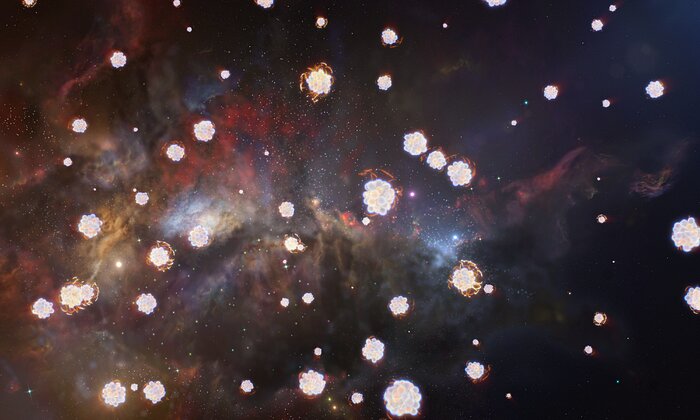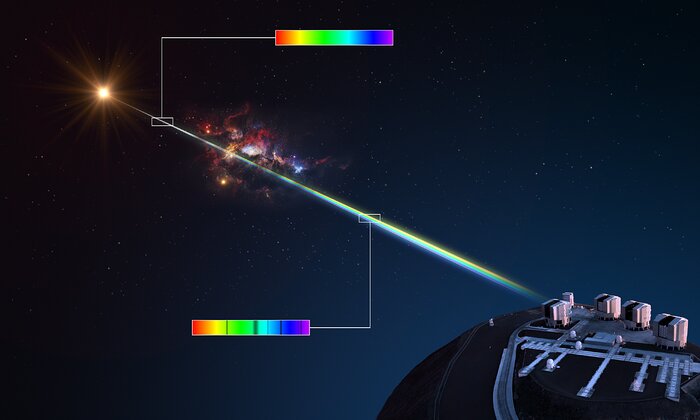When the first stars appeared more than 13.5 billion years ago, the universe consisted only of nature’s simplest chemical elements : hydrogen and helium. The elements that make up our own bodies, such as carbon, oxygen and iron, were first synthesized inside the first stars and then released into the surrounding gas by the first supernova explosions that occurred when massive stars died.
The nature of primordial stars is still unknown. However, these stars can be studied indirectly through the detection of chemical elements that they dispersed into the environment, after their death, and that are still present in the diffuse gas or that have been incorporated by the following generations of so-called "normal" stars.

Grâce au Very Large Telescope de l’ESO, des astronomes ont détecté trois nuages de gaz lointains dont la composition chimique correspond à ce que nous attendons des explosions des premières étoiles apparues dans l’Univers. Ces premières étoiles peuvent être étudiées indirectement en analysant les éléments chimiques qu’elles ont dispersés dans le milieu environnant après leur mort dans l’explosion d’une supernova. Les trois nuages de gaz lointains détectés dans cette étude sont riches en carbone, en oxygène et en magnésium, mais pauvres en fer. C’est exactement la signature attendue des explosions des premières étoiles.
The study in the May 3, 2023, issue of Astrophysical Journal was based on analysis of archival data from a sample of 100 spectra of large spectral shift quasars obtained with the X-shooter spectrograph, installed on ESO’s Very Large Telescope. It reports for the first time the detection of three distant gas clouds with a chemical composition consistent with what is expected from early stellar explosions.

Lorsque la lumière du quasar traverse le nuage de gaz, les éléments chimiques qu’il contient absorbent différentes couleurs ou longueurs d’onde, laissant des lignes sombres dans le spectre du quasar. Chaque élément laisse un ensemble différent de raies. En étudiant le spectre, les astronomes peuvent donc déterminer la composition chimique du nuage de gaz intermédiaire.
"For the first time, we have been able to identify the chemical traces of the explosions of the first stars in very distant gas clouds, observed when the Universe was only 10-15% of its size", explains Andrea Saccardi, a doctoral student at Paris Observatory - PSL, who conducted the study as part of his master’s thesis at the University of Florence.
These clouds have a very low iron content, but show an overabundance of carbon and other light elements. This particular chemical composition has also been observed in many old stars in our galaxy, which the researchers consider to be second generation stars that formed directly from the "ashes" of the first.
Why is this result important ?
We know that stars are formed from gas. There are therefore gas clouds in the distant (and early) Universe with the same chemical composition as the second generation stars in our Galaxy. This work has thus allowed to identify them and to understand which types of gas clouds must be analyzed to reveal the chemical signature of the first supernovae.
This discovery opens new ways to study indirectly the nature of the first stars, fully complementing the stellar archaeology studies of the ancient stars in our Galaxy.
Reference
The article is published as "Evidence of first stars-enriched gas in high-redshift absorbers" by Andrea Saccardi and all, in the journal Astrophysical Journal dated May 3, 2023.
DOI : 10.3847/1538-4357/acc39f
For more information
From the ESO website : "Astronomers find distant gas clouds with leftovers of the first stars" - Science Release eso2306
